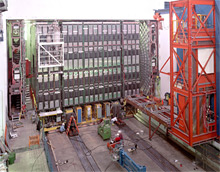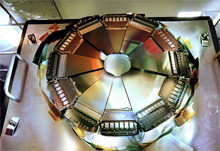Energy Frontier
DZero
How it works
DZero is one of two detectors positioned along the four-mile Tevatron accelerator ring.It takes its name from its location on the ring, D0. Physicists use the detector to study the array of particles and forces in nature by recording data about collisions of protons and anti-protons in the accelerator. The 5,500-ton detector sits more than four stories tall and is composed of more than 1 million individual detector elements.
Beams of protons and antiprotons collide at the center of DZero at nearly the speed of light, creating flashes of energy that condense into particles that in turn decay into more stable particles. This volatile process replicates the conditions just after the big bang. The beams cross paths in the detector an average of 1.7 million times per second. When they cross, one or many pairs of protons and antiprotons can collide. Because mass is energy in a different form, the kinetic energy from the collision can convert briefly into massive particles heavier than the protons and antiprotons involved in the collision. For interesting events, the detectors record information necessary to evaluate the energy, momentum and electric charge of the emerging particles.
DZero measures particles with three types of layers of detectors. As particles pass through the innermost layers, made up of tracking detectors, they leave traces of energy that allow researchers to map their flight paths. DZero records this information with a series of silicon detectors nestled scintillating fiber detectors mounted on carbon fiber supports.
The second layers consist of calorimeters, which measure the energy of showers of particles by absorbing them. DZero houses a unique set of precise calorimeters filled with liquid argon. Another of the strengths of the DZero detector is its comprehensive outer shell of muon detectors. Three layers of the detectors catch the signals of muons that escape the inner layers of the detector.
Video of DZero detector being installed
Questions for the Universe
Collaboration
The DZero collaboration consists of researchers from about 90 institutions in 18 countries. DZero members come from the world’s leading universities and laboratories. The collaboration consists of about 540 members, including about 130 graduate students and about 100 postdoctoral researchers. The collaboration membership splits nearly evenly between U.S. participants and those from foreign laboratories and universities.
Scientific results
Historical results:
Physicists observed the first proton-antiproton collisions produced by the Tevatron on Oct. 13, 1985. Since then, researchers at the CDF and DZero experiments have used the Tevatron to study matter at ever smaller scales.
On March 2, 1995, physicists at CDF and DZero announced the discovery of the top quark. Researchers in both collaborations had statistically proven observation of the top quark in collisions at their detectors.
The top quark, which is as heavy as a gold atom but much smaller than a proton, was the last undiscovered quark of the six predicted to exist by current scientific theory. Scientists worldwide had sought the top quark since the discovery of the bottom quark at Fermilab through fixed-target experiments in 1977.
Both collaborations were subsequently able to measure the mass of the top quark to high precision. Particle physicists measure particle masses to verify the correctness and accuracy of their particle models. Knowing the value of the top quark mass has allowed physicists to zero in on the mass of the undiscovered Higgs boson, a crucial component of the theoretical framework of particle physics.
Current program:
- Last modified
- 05/06/2014
- email Fermilab



